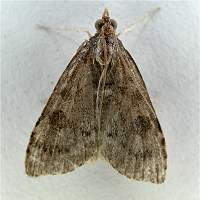Udea prunalis
Udea prunalis does not have a vernacular name. Probably because it is not a very striking species. Still it is not very difficult to identify. Not too far from the lowest edge of the wing is a jagged line. Above this line a big dark dot and above this dot another dark dot, but much smaller. These markings are in a kind of blackish or brownish grey. The wing itself is always a kind of grey. The body and legs are strikingly white. Like most species from this genus the wingspan is around 2.5cm.
The eggs are being laid in summer, but hatch in autumn. The larvae do feed, but don't grow very fast. By the end of autumn the small caterpillars spin a cocoon. It is attached to the edge of a leaf. In it, the larva overwinters. Such a cocoon made for overwintering is called a hibernaculum. In spring the larva reemerges and starts feeding again. This time is lives on the lower side of a leaf which is spun together for protection. By the end of spring a silken cocoon is made, attached between leaves of the food plant and in it pupation takes place. The larvae are found on a great number of plants, including deadnettle, woundwort, dog's mercury, nettles, honeysuckle and many others.
Udea prunalis is a typical summer species, on the wing from June to mid August. It flies about actively by night only, but is easily disturbed during the day. The species depends on thickets and hedges. Comes to light quite freely. Found all over the British Isles where hedges grow, often in very great numbers. The same applies to other parts of Europe.
Udea prunalis does not have a vernacular name. Probably because it is not a very striking species. Still it is not very difficult to identify. Not too far from the lowest edge of the wing is a jagged line. Above this line a big dark dot and above this dot another dark dot, but much smaller. These markings are in a kind of blackish or brownish grey. The wing itself is always a kind of grey. The body and legs are strikingly white. Like most species from this genus the wingspan is around 2.5cm.
The eggs are being laid in summer, but hatch in autumn. The larvae do feed, but don't grow very fast. By the end of autumn the small caterpillars spin a cocoon. It is attached to the edge of a leaf. In it, the larva overwinters. Such a cocoon made for overwintering is called a hibernaculum. In spring the larva reemerges and starts feeding again. This time is lives on the lower side of a leaf which is spun together for protection. By the end of spring a silken cocoon is made, attached between leaves of the food plant and in it pupation takes place. The larvae are found on a great number of plants, including deadnettle, woundwort, dog's mercury, nettles, honeysuckle and many others.
Udea prunalis is a typical summer species, on the wing from June to mid August. It flies about actively by night only, but is easily disturbed during the day. The species depends on thickets and hedges. Comes to light quite freely. Found all over the British Isles where hedges grow, often in very great numbers. The same applies to other parts of Europe.




